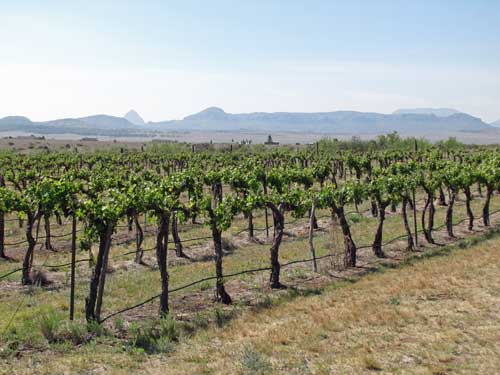
Oh, What a Beautiful Morning. Oh, What a Beautiful Place for Cabernet in Fort Davis, Texas
Out in Fort Davis, Texas, on a path definitely less traveled, I’m a long way from Houston over 500 miles and still in Texas. Fresh, dry air and Mountain breezes greet me as I, in turn, give a return greeting to the new day.
Why come to Fort Davis? Well, the history of the modern Texas wine industry shows that some of the best red wine grapes grown in the state have come from a vineyard in the surrounding Texas Davis Mountains viticultural area nearly a mile high. A mix of complex volcanic soil, dry mountain air and warm Texas sunshine.
The reputation for red wines from this region was defined by Blue Mountain Vineyards that garnered gold medals in the Lone Star wine competition seemingly whenever winemaker Patrick Johnson decided to enter his wines. In a conversation with him before leaving Houston, I ask Patrick what was so special about the Cabernet grapes grown in the Texas Davis Mountains AVA. He said, “They are simply perfect. The Brix, pH and VA are all right there. Once I get the grapes into the winery, they just about make wine by themselves”.
It is interesting to me that Patrick said that. A few weeks ago I was in Buffalo Gap for the Wine and Food Summit that invites a select few Texas and California winemakers. I asked the same question to Napa Valley winemakers about their mainstay Cabernet and I literally got the same answer….”The Cabernet grapes from Napa Valley vineyards almost make wine by themselves.” They referred to Cabernet Sauvignon as “in the sweet-spot” for Napa Valley grape growing. This made me realize Texas needs to find and then focus on is its sweet spot, or due to the size of the state, it perhaps needs to look for its sweet spots.
For those of you looking for more detailed information on Texas wine country (i.e. characteristics of the places in Texas where grapes are actually grown, I suggest going to the “Winegrowing Regions of Texas” website at: http://txwineregions.tamu.edu. This site has information on the location and lay of the land of every viticultural area in the state along with its geology, soils, and climate. Owed mostly to its expanse, Texas has widely varying growing. To put this in perspective, it’s something like describing the extreme differences between Bordeaux, Burgundy, Alsace and the Rhone Valley in France, as Texas and France are of similar proportions.
Back to the Texas Davis Mountains AVA…..It’s located in Jeff Davis County, in the Trans-Pecos region of West Texas with an area of approximately 270,000 acres. This viticultural area is at the highest elevation of all Texas wine regions and is surrounded by the unique conditions of the Chihuahuan desert. The land within the boundaries of the AVA ranges between 4,500 feet and 8,300 feet above sea level. This is just a tad higher than my hometown of Houston on the opposite edge of Texas that sits at about 45 feet provided we don’t have a hard rain. Due to the mile-high elevation around Fort Davis, the climate of this region is the most moderate in Texas with cool nights even after hot summer days. Vineyard soils are mineral rich and nutrient poor, a formula for good grape production while minimizing vine production. More details on the Texas Davis Mountains growing region can be found at: http://txwineregions.tamu.edu/davis_tech.htm.
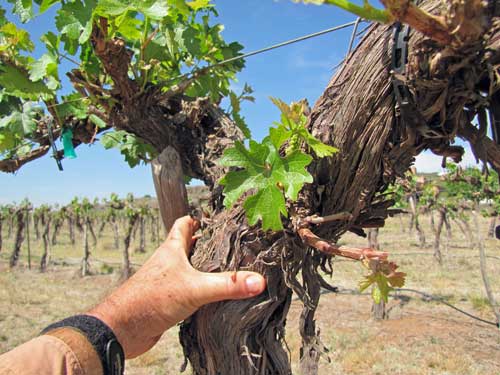
Yesterday, I found two of the vineyards around Fort Davis. The first was the vineyard in operation near Delores Mountain growing Cabernet Sauvignon and Sauvignon Blanc for Bob Cottle’s Pleasant Hill Winery in Brenham, Texas. It’s a compact vineyard with the Cabernet occupying the uphill ground in the back and the Sauvignon Blanc in the lower ground in front. The vineyard was planted many years ago, perhaps 25 to 30 years by the looks of the vines. These vines are old and gnarly; hearty, keepers of the Texas wine legacy.
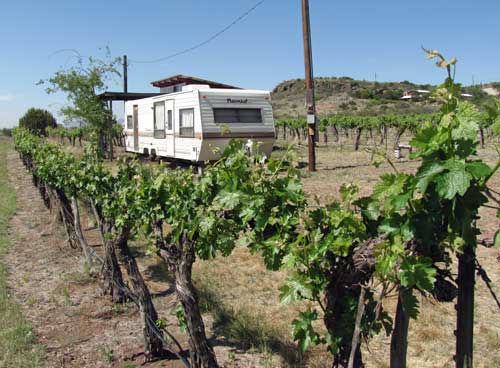
The vineyard surrounded what, in true Bordelaisian tradition, Bob calls his “Chateau Le Trailer”. It’s his field office and living space when he comes out to work the vineyard during the growing season and to do off season pruning and maintenance work. At Chateau Le Trailer, the Cabernet seemed to be pushing out a bit further than the Sauvignon Blanc. The irrigation was on and I examined the soil of light ochre color that turn to brown when wet. The leaves on the vines were well formed with no evidence of disease and fungal pressure with numerous clusters of immature green berries still smaller than buckshot. All in all, it looked like a good start to this year’s growing season.
I traveled on southwest of Fort Davis on my quest to find the old Blue Mountain vineyard and winery. After stopping at a local residence, I was directed back up the road to a white, washed-out sign that fronted huge Blue Mountain in the background. On the sign, in faded letter read, “Blue Mountain Vineyard”. The gate was locked and a for sale sign was implanted next to it, but no vineyard was in sight.
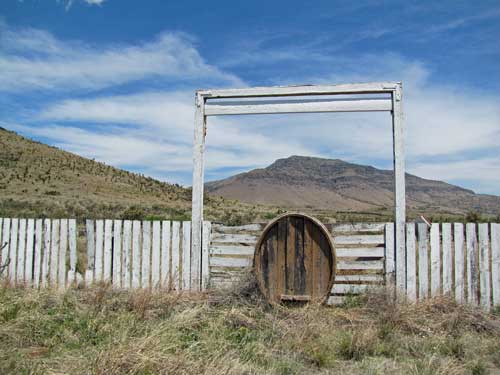
I climbed the fence and hiked a far piece up the winding dirt road until finally I could make out in the distance linear rows of trellising that held the remnants of the Blue Mountain vineyard. It was more of a bone yard than a vineyard. Deceased vines stood with their outstretched fingers reaching for the sky as if in pain. A sparse few vines showed green tendrils that are now left unattended.
Alas, the rich Cabernet the Blue Mountain vineyard once provided is no more. It succumbed unexpectedly to the perils of Pierce’s Disease, often referred to as simply, “PD”, common to hotter, wetter regions of Texas and in southern and central coast vineyards in California. You known, it’s a pity. Today, viticulturists in Texas have developed treatments and new vineyard practices that mitigate this peril to a more tolerable and manageable level. What we known today, this vineyard could likely have been spared its untimely demise.
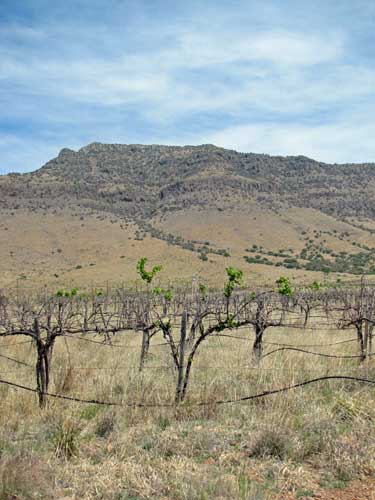
Blue Mountain Vineyard lives on in my cellar for at least a bit longer. I have three bottles of its deep, dark Cabernet Sauvignon coming on twelve years now. From the tasting of the last bottle that I drew from my storage, the wine was mature with a well-established complex bouquet; still holding substantial dark berry characteristics augmented with cedar and cigar box qualities. Hopefully, other bottles of Blue Mountain Vineyard Cabernet Sauvignon are resting comfortably under considerably more care than the vines that once bore their grapes. These wines await quietly, but now impatiently, to be consumed before their characteristics fade to only a ghostly mirage of this vineyards glory past.

Hey Russ, Great article about the Davis mountain region. So many people do not know how great the wines are from here. I have been fortunate to try some of these wines and I will agree with you about the cab!
Not to mention have you heard the song by Dave Insley called “West Texas Wine” He sings about the wine from this area. I just discovered this song and I have been wanting to take a trip out there to see the place myself. Luz De Estrella makes some great wines from this region, but I would not hold onto the wines very long because they bottle everything with twin top corks instead of full corks and after about 3 years the wine starts to taint.
I had an 04 Cab from Luz that was spectacular but sadly was tainted.
Who else other than Luz de Estrella produces wines from the blue mountain vineyards?
nice….very nice….
I’d love to know where Patrick Johnson is now. He’s the stuff of legend in the Hill Country, where I’ve just moved. A young winery worker @ Pedernales Cellars spoke of PJ with stars in this eyes, so I had to know more. A query on Chow.com led here. . .
Patrick Johnson is alive and well and living in Alpine, Texas. After the demise of the Blue Mountain Vineyard to Pierce’s Disease, he has been traveling around the state as consulting winemaker and also manages and consults for several vineayards in and around Alpine, Marfa and Fort Davis.
Is there any way to contact Mr. Johnson? I am a young winery worker from Pedernales Cellars, and would love to talk to him. Any contacts in that region would be extremely appreciated. Thanks
He is alive and living in Alpine, Texas. I will try to send you the information to your email address.
Best wine from Texas I ever had came from there, prod;uced by Don Brady. The big issue there seems to be where is the water? BGS
That was a hell of a vineyard while it lasted. I wish you the best of success and please update me as thing progress.
Russ